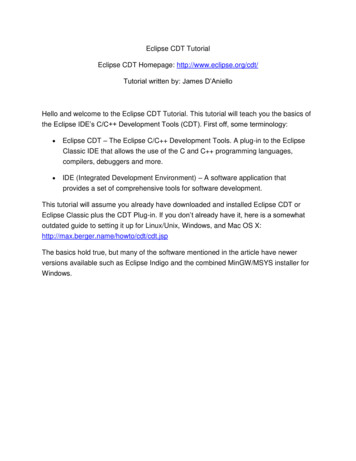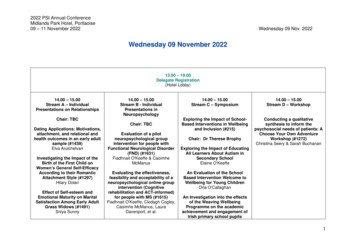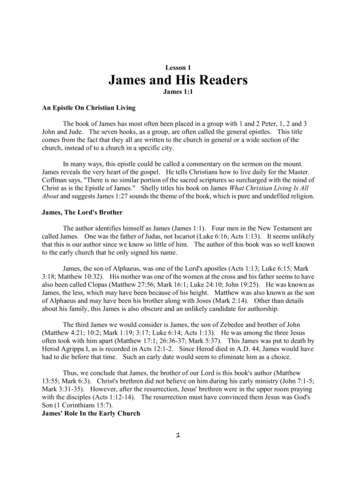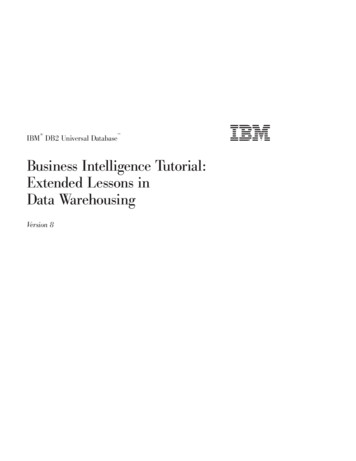
Transcription
Eclipse CDT TutorialEclipse CDT Homepage: http://www.eclipse.org/cdt/Tutorial written by: James D’AnielloHello and welcome to the Eclipse CDT Tutorial. This tutorial will teach you the basics ofthe Eclipse IDE’s C/C Development Tools (CDT). First off, some terminology: Eclipse CDT – The Eclipse C/C Development Tools. A plug-in to the EclipseClassic IDE that allows the use of the C and C programming languages,compilers, debuggers and more. IDE (Integrated Development Environment) – A software application thatprovides a set of comprehensive tools for software development.This tutorial will assume you already have downloaded and installed Eclipse CDT orEclipse Classic plus the CDT Plug-in. If you don’t already have it, here is a somewhatoutdated guide to setting it up for Linux/Unix, Windows, and Mac OS X:http://max.berger.name/howto/cdt/cdt.jspThe basics hold true, but many of the software mentioned in the article have newerversions available such as Eclipse Indigo and the combined MinGW/MSYS installer forWindows.
Table of Contents Making Your First Project in Eclipse Command Line Arguments in Eclipse Managing Multiple Files in Eclipse Syntax Made Easier in Eclipse Making Eclipse Your Own Beyond This Tutorial License
Making Your First Project in Eclipse1. Open up Eclipse (by either typing “eclipse” in a terminal window or going to theApplications tab at the top, select Programming then select Eclipse).2. Set up your workspacea. Your workspace is where your projects will be saved. I advise making anew folder for your workspace because it will place many files and foldersin this destination.3. Close the welcome tab (if you have one)4. Go to Window Open Perspective Other5. Click on C/C and click OK6. Now go to File New C Project7. Name your project “HelloWorld”.a. Under “Project Type”, open the “Executable” Folder and click on “HelloWorld C Project” and make sure that the correct Toolchain ishighlighted on the right.b. For Windows, that would be either MinGW GCC or Cygwin GCC. LinuxGCC for Linux, and MacOSX GCC for Mac.c. Press Next8. Enter any information you want into the Author, Copyright, Hello World Greeting,and Source fields (it is OK to leave values as they are).9. Press Next10. Make sure Debug AND Release are checked, then click Finish11. Now you will see your source code appear in the middle window like the picturebelowa. if you don't see the code in the middle window, under the Project Explorertab on the left, double click on HelloWorld and then double click on src,then double click on HelloWorld.cpp.
12. But before you can run your program, you must build it for the first time.13. Go to Project Build All. You don’t want to do this every time though, so after itis built, make sure Project Build Automatically is checked.14. Now it’s time to run your program. Go to Run Run. (If it asks you what to run,select “Release”). (I have had problems with Run not appearing under the Runtab on the first try; move the cursor someplace else and come back to the Runtab and you should see Run now). Alternatively, you could use Ctrl F11 to dothe same.15. Your program will run and output to the console at the bottom of your screen likeso:16. Say you wanted to change some of your code. Use your mouse and keyboard tochange “!!!Hello World!!!” to “Hello Eclipse!”.17. Whenever you change something, it is always a good idea to save it. Go to File Save to save your work. However, if you are going to run the program afterchanging something, it will ask you if you would like to save your changes.
18. Because we already checked “Build Automatically”, we can simply go to Run Run and it will build and run our program. If you have not saved your changes, itwill also ask you if you would like to save your changes.19. Now the console shows this:20. Congratulations! You’ve successfully built and ran your first program in EclipseCDT.Command Line Arguments in Eclipse (if using argv and argc in your C program)1. I want to briefly cover command line arguments in Eclipse because they aredifferent compared to just typing “HelloWorld argument1 argument2” into aterminal.2. Go to Run Run Configurations 3. Click on the tab that says “Arguments”4. Enter your command line arguments in the box labeled “Program arguments:”5. Press “Run”.6. Since the HelloWorld program does not use argv and argc, doing this will haveno effect.Managing Multiple Files in Eclipse1. What if you want to add a data file to your program?
2. Go to your program’s folder in the Project Explorer:3. And right-click on the folder HelloWorld and go to New File.4. Call it “datafile.txt”a. Now you will have an empty file in the middle of your screen that you caninput data to be used if your program reads from a file5. If you would like to create a header file, you can right click on your program’sfolder in the Project Explorer and go to New Header File.6. Call your header file “HelloHeader.h”. Notice that Eclipse automatically generatesyour header file with the following statements where you can insert your code:7. Also, now you can switch between your source and data files by simply clickingon their tabs.Syntax Made Easier in Eclipse1. Another wonderful feature of Eclipse is the syntax highlighting. This featurecomes standard in many, many text editors as well, so how is syntax madeeasier in Eclipse?2. Eclipse dynamically checks for errors without compiling and just like your favoriteword processor, will underline errors and provide suggestions on how to fix them.
3. Take the following code for example: (note, while typing this code, Eclipse assistsyou by inserting various characters that it is certain you will use. Watch thescreen while typing.)4. Eclipse is letting me know that there is an error through multiple signals.1) The tab for “HelloWorld.cpp” has an ‘x’ in the left area of the tab.2) The variable “counter” is underlined in red3) There is an image of a X on the lines with the errors5. I failed to declare the variable “counter”, and Eclipse knows this and will give mesuggestions on how to fix this error before I compile it. Click on the X image, andEclipse will give you suggestions on how to fix it:6. Eclipse also has a spellchecker that works in commentsMaking Eclipse Your Own1. First off, there are many more tools within Eclipse that were not covered withinthis tutorial.2. However, one useful and time-saving option is the keyboard shortcuts menu.
3. Go to Window Preferences4. Open the “General” folder and then click on “Keys”5. From here you can change the keyboard shortcut scheme to that of eitherMicrosoft Visual Studio or Emacs, or you may bind your own keyboard shortcuts.6. While in the “Preferences” window, you can open up the “C/C ” folder and clickon “Code Style”.7. The default profile (K&R) puts the opening brace of a function on the same lineas the function’s name, however you can change the profile to GNU for the braceto be put on the following line instead. Again, you can also change the formattinghowever you would like to.8. You can also tweak any other setting in the Preferences menu to your liking.Beyond This TutorialIf you would like to learn more about Eclipse, you can visit the official EclipseDocumentation at: http://www.eclipse.org/documentation/
Eclipse CDT Tutorial by James D'Aniello is licensed under a Creative Commons Attribution-ShareAlike 3.0 Unported License.
the Eclipse IDE's C/C Development Tools (CDT). First off, some terminology: -Eclipse CDT The Eclipse C/C Development Tools. A plug-in to the Eclipse Classic IDE that allows the use of the C and C programming languages, compilers, debuggers and more. -IDE (Integrated Development Environment) A software application that











